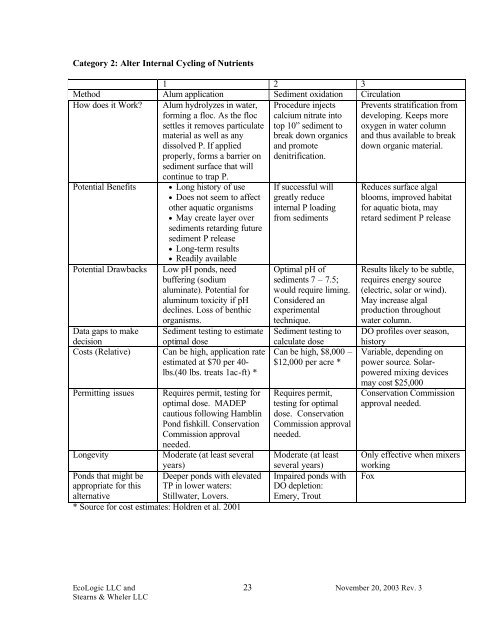Action Plan for the Town of Chatham Ponds
rev 3a report.pdf - Town to Chatham
rev 3a report.pdf - Town to Chatham
Create successful ePaper yourself
Turn your PDF publications into a flip-book with our unique Google optimized e-Paper software.
Category 2: Alter Internal Cycling <strong>of</strong> Nutrients<br />
1 2 3<br />
Method Alum application Sediment oxidation Circulation<br />
How does it Work? Alum hydrolyzes in water,<br />
<strong>for</strong>ming a floc. As <strong>the</strong> floc<br />
settles it removes particulate<br />
material as well as any<br />
dissolved P. If applied<br />
properly, <strong>for</strong>ms a barrier on<br />
sediment surface that will<br />
continue to trap P.<br />
Procedure injects<br />
calcium nitrate into<br />
top 10” sediment to<br />
break down organics<br />
and promote<br />
denitrification.<br />
Potential Benefits<br />
Potential Drawbacks<br />
Data gaps to make<br />
decision<br />
Costs (Relative)<br />
Permitting issues<br />
Longevity<br />
<strong>Ponds</strong> that might be<br />
appropriate <strong>for</strong> this<br />
alternative<br />
• Long history <strong>of</strong> use<br />
• Does not seem to affect<br />
o<strong>the</strong>r aquatic organisms<br />
• May create layer over<br />
sediments retarding future<br />
sediment P release<br />
• Long-term results<br />
• Readily available<br />
Low pH ponds, need<br />
buffering (sodium<br />
aluminate). Potential <strong>for</strong><br />
aluminum toxicity if pH<br />
declines. Loss <strong>of</strong> benthic<br />
organisms.<br />
Sediment testing to estimate<br />
optimal dose<br />
Can be high, application rate<br />
estimated at $70 per 40-<br />
lbs.(40 lbs. treats 1ac-ft) *<br />
Requires permit, testing <strong>for</strong><br />
optimal dose. MADEP<br />
cautious following Hamblin<br />
Pond fishkill. Conservation<br />
Commission approval<br />
needed.<br />
Moderate (at least several<br />
years)<br />
Deeper ponds with elevated<br />
TP in lower waters:<br />
Stillwater, Lovers.<br />
* Source <strong>for</strong> cost estimates: Holdren et al. 2001<br />
If successful will<br />
greatly reduce<br />
internal P loading<br />
from sediments<br />
Optimal pH <strong>of</strong><br />
sediments 7 – 7.5;<br />
would require liming.<br />
Considered an<br />
experimental<br />
technique.<br />
Sediment testing to<br />
calculate dose<br />
Can be high, $8,000 –<br />
$12,000 per acre *<br />
Requires permit,<br />
testing <strong>for</strong> optimal<br />
dose. Conservation<br />
Commission approval<br />
needed.<br />
Moderate (at least<br />
several years)<br />
Impaired ponds with<br />
DO depletion:<br />
Emery, Trout<br />
Prevents stratification from<br />
developing. Keeps more<br />
oxygen in water column<br />
and thus available to break<br />
down organic material.<br />
Reduces surface algal<br />
blooms, improved habitat<br />
<strong>for</strong> aquatic biota, may<br />
retard sediment P release<br />
Results likely to be subtle,<br />
requires energy source<br />
(electric, solar or wind).<br />
May increase algal<br />
production throughout<br />
water column.<br />
DO pr<strong>of</strong>iles over season,<br />
history<br />
Variable, depending on<br />
power source. Solarpowered<br />
mixing devices<br />
may cost $25,000<br />
Conservation Commission<br />
approval needed.<br />
Only effective when mixers<br />
working<br />
Fox<br />
EcoLogic LLC and 23<br />
November 20, 2003 Rev. 3<br />
Stearns & Wheler LLC
















